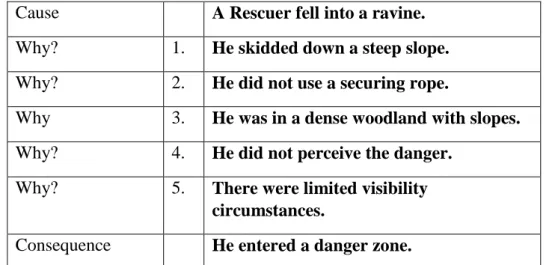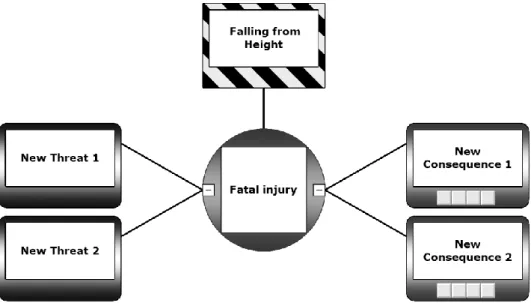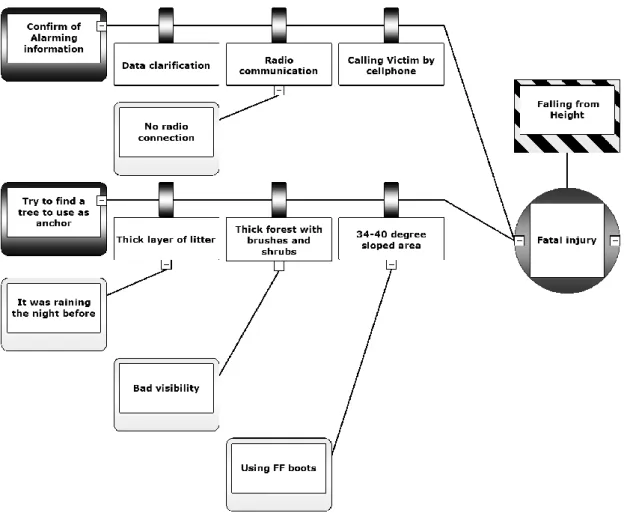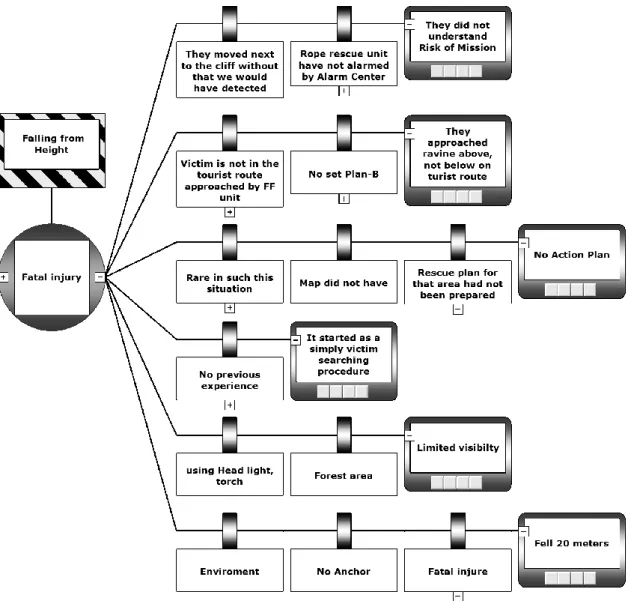INVESTIGATING A ROPE RESCUE ACCIDENT
EGY KÖTÉLTECHNIKAI MENTÉSI BALESET VIZSGÁLATA
JACKOVICS Péter; KOVÁCS Tibor
(ORCID: 0000-0002-1809-029X); (ORCID: 0000-0001-7609-9287) peter.jackovics@katved.gov.hu; kovacs.tibor@bgk-uni.obuda.hu
Abstract
The investigation of accidents occurring during high- or low-angle rope rescue, due to peculiarities and specific circumstances provides us with extraordinary lessons learnt, so that we can disregard the template-like content of minutes taken on work accidents, and used up-to-date analysis methods avoiding subjectivity, like next generation Visual Risk Assessment software and tool, the Bowtie Method (BowTieXP).
The analysis of different risks was performed using up-to date accident investigation methods in order to fully analyse the cause and effect circumstances from all sides.
It can be seen after the analysis of the case that human role is fundamental in the occurrence of the accident, since, substantially; a human error caused the accident. The Human Error of the commander and the rope rescuer strengthened the causes of the occurrence of the accident, which was strengthened by environmental, procedural, training and technical factors.
Keywords: Rope Rescue, Accident, BowTie Method,
Absztrakt
A kötéltechnikai eszközökkel végzett magasból vagy mélyből történt mentések során bekövetkezett balesetek vizsgálata, a különlegesség, az egyedi körülmények miatt rendkívül tanulságokkal szolgál úgy, hogy eltekintünk a munkabaleseti jegyzőkönyvek sablonosságától, alkalmazzuk szubjektivitást mellőző modern szoftveres elemzési módszereket így, mint a Csokornyakkendő analízist. A tanulmány célja egy súlyos mentési baleset feldolgozásával megvizsgálni a különleges mentések során bekövetkezett balesetek kockázatait, a tanulságait, hogy hasonló eset ne következzen még egyszer be.
A különböző kockázatok elemzése modern balesetei vizsgálati módszerekkel történt, azért, hogy minden oldalról az ok-okozati körülmények maradéktalanul ki legyenek elemezve a mentést vezető és a mentést végző szakszemélyzet emberi hibázásai, a vezetői döntésekre és a kötéltechnikai mentési eljárásra ható környezeti és technikai tényezők.
Kulcsszavak: Kötéltechnikai Mentés, Baleset, Csokornyakkendő Módszer
A kézirat benyújtásának dátuma (Date of the submission): 2018.04.03.
A kézirat elfogadásának dátuma (Date of the acceptance): 2018.06.06.
INTRUDUCTION
The cause and effect investigation of severe injuries during high- and low-angle rope rescue can be regarded as peculiar from many aspects, since due to extreme circumstances and uniqueness, the reasons of these accidents is quite difficult scrutinize posterior, and it is also difficult analyze and evaluate their effects. The accidents within the rope rescue system are primarily investigated within a legal framework and are processed based on accidents protocols prescribed thereby. The strict administration liability does not allow the full elaboration, analysis and evaluation of the cause and effect circumstances of accidents and to collect the lessons learnt.
The investigation of accidents occurring during high- or low-angle rope rescue, due to peculiarities and specific circumstances provides us with extraordinary lessons learnt, so that we can disregard the template-like content of minutes taken on work accidents, and used up-to- date analysis methods avoiding subjectivity, like the Bowtie Method [1].
Severe work accidents involving fatal injuries at rescue units of rope rescue organizations are very rare. Due its uniqueness, it is important to investigate the circumstances and reasons of their occurrence in order to reduce the risks of the occurrence of further accidents; by doing so, to save the lives of rescuers performing this dangerous intervention. The safeguarding of the lives and health of responders is just as an important aspect as to increase the chance of survival of a rescue and to save their life and health.
The goal of this study is, by elaborating an accident, to investigate and analyze the risks of accidents occurring during special rescue operations and to share the lessons learnt with rescuers in order to avoid similar incidents. The analysis of different risks was performed using up-to date accident investigation methods in order to fully analyze the cause and effect circumstances from all sides.
STATE OF THE ART
The investigation of accidents occurring during high- or low-angle rope rescue, due to peculiarities and specific circumstances provides us with extraordinary lessons learnt, so that we can disregard the template-like content of minutes taken on work accidents, and used up-to- date analysis methods avoiding subjectivity, like the Bowtie Method.
DESCRIPTION OF THE SEVERE WORK ACCIDENT1
In autumn, at late afternoon, the operations control received a notification that a person fell into a ravine outside the administrative area of an inhabited place and was injured. On the day of the alert, there was no rainfall, it was dark. In addition to the floodlights, there was no other lighting.
During the reconnaissance, starting from the direction of city, on a road accessible by a four- wheel-drive vehicle, but not by a vehicle, it took 700 meters to turn up at the incident site.
During the reconnaissance, no one was found there, only a soft shouting was heard from the forest. Then, the rescuers went in the direction of this voice. To approach the source of the voice, they had to descend on a slope of 35-40 degrees, covered with leaves and trees, approx.
50 meters to the place of the slip. Rope securing in this place, due to the vicinity and the accessibility of the landmarks (trees, bushes) was not justifiable. The terrain conditions
hampered the possibility of skidding. During the reconnaissance, headlights and torches were used.
General description of the incident site: open view on the top of the cliff ledge, climbing 15- 20 meters on a slope, relatively steep (approx. 60-70 degrees slope angle), covered with dry leaves and loose soil, opposite of the supposed place of the fall or skidding.
One of the rescuers of the rescue team was looking for an anchor point, when he slipped at the place indicated above; first, he skidded approx. 4 meters slowly, then rapidly on an 8-meter- long slope of approx. 60 degrees; and in the following, he fell vertically approx. 20 meters.
According to the primary investigation, he died immediately.
WHAT HAPPENED? WHY DID IT HAPPEN?
At the occurrence of an accident, we always investigate the causes: a rescuer fell into a ravine.
Why did the accident occur? What happened during the accident? – we can ask the questions.
We may start the investigation by asking the five why-questions, at the end of which we can find the cause(s) triggering the accident. The rescuer, due to the bad visibility and the extreme terrain as aggregate causes of environmental effects did not perceive that he had stepped on to a steep and sloping area, from where he can longer return, there, without rope securing, he would surely fall into the ravine.
Cause A Rescuer fell into a ravine.
Why? 1. He skidded down a steep slope.
Why? 2. He did not use a securing rope.
Why 3. He was in a dense woodland with slopes.
Why? 4. He did not perceive the danger.
Why? 5. There were limited visibility circumstances.
Consequence He entered a danger zone.
Table 1.The “5 Why?” questions about the causes of the accident (Source: Created by the authors)
The area from where it is no longer possible to climb back because it is steep and slippery is called a danger zone by experts involved in cave search and rescue, cliff climbing or mountaineering rescue. The individual sections of the terrain and caves have their danger zones, whose locations and sizes are different, so they are difficult to define, usually they are empirically determined and identified. In the indicated area with ravines, this danger zone was not marked or outlined; such dangers of the area were not known to the rescue unit, and there is another significant fact that, due the limited visibility circumstances as well, they did not perceive the risks of the mountainous and forested environment.
RESEARCH METHODOLOGY
“The Bowtie method is a risk evaluation method that can be used to analyze and demonstrate causal relationships in high risk scenarios. The method takes its name from the shape of the diagram that you create, which looks like a men’s bowtie. A Bowtie diagram does two things.
First of all, a Bowtie gives a visual summary of all plausible accident scenarios that could exist
around a certain Hazard. Second, by identifying control measures the Bowtie displays what a company does to control those scenarios” [1].
ANALYSIS OF THE SEQUENCE OF EVENTS – WHO DID WHAT?
During the chronological analysis of the sequence of events, the critical mistakes are unambiguously visible that may have caused the accident. The more different methods we use to analyze the given accident, the more recurring causes we may see, which, individually or collectively, may have resulted in the occurrence of the severe accident. Let us examine the incident with different methods, but first, let us take a look at the circumstances, the sequence of events how the accident may have occurred.
The sequence of events can be reconstructed retrospectively from the minutes of the accident, which clearly shows that the events can be divided into 13 key steps. From the minutes, based on the factual findings of the investigation, critical points can be assigned to the given steps. Collecting the critical points is not yet the analysis of the incident; it is a kind of a sketch of facts. To analyze the information collected from the sketch of facts and the documentation several years and rescue, command and control knowledge and experience are required [2].
Based on the knowledge of the critical points, we can see that the cause of the occurrence of the accident is expected to be complex. Beyond individual responsibility, the correctness of and the lessons learnt from the organization, the commander and the methods and procedure must be analyzed. We should examine how the environment and the level of training, the use or not use of individual protection equipment and other tools and instruments have aggravated the accident, that is how they have increased the occurrence of the accident resulting from skidding, [3].
During the analysis, we always investigate:
Why did it occur? What would have happened if…?
Why did a rescuer colleague of ours die?
How can we prevent the occurrence of similar incidents in the future?
What are the lessons learnt for us?
These questions are not simple because the causes of the given accident are also complex.
Each and every critical point involved a risk of certain gravity:
a long walk to the incident site, which could cause fatigue,
incorrect information regarding the location and the position of the injured,
dense woodland with limited visibility,
steep hillside,
night darkness,
presumably lighting devices with poor illumination capabilities,
difficult terrain, heavy protective clothing,
slippery terrain, thick litter layer of dead leaves,
locating the missing person by his voice,
steep hillside,
Circumstances of anchoring the securing rope.
RISK ASSESSMENT OF THE ACCIDENT WITH THE BOWTIE-XP SOFTWARE The Bowtie representation of evaluating of the causes and consequences of the accident causing a fatal injury is a good method, where the results of the fault tree method and the herringbone technique can be depicted in an aggregate way. The risk analysis of the fatal accident of a rescuer and its evaluation and representation using the Bowtie method is shown in Figures 1-3.
The left hand side of the bowtie analyzes the causes of the occurrence of the accident; its right hand side analyzes the consequences, effects and aftermaths of the accident. In the centre, we can see the result of the accident as an event and main danger [4][5].
Figure 1:First step: Hazard and Top Event in BowTieXP with Major Accident Hazard (Source: Composition of the authors)
Both sides of the bowtie figure contain the limits that may hinder or mitigate the occurrence of the event, respectively, its effects. So, on one side, data clarification, communication, coordination by the duty office, and on the other side, decisive instruction by the commander, a tactical decision and the training of subordinate commanders [5]. The detailed analyses are depicted by the figures of the fishbone (Ishikawa methodology) diagram and the fault tree method (Event Tree Analysis, ETA).
Figure 2:Examples of Hazard, Top Event, Threats, Outcome and Barriers on left side of BowTie diagram with selected Threats (Source: Composition of the authors)
DISCUSSION
It can be seen, the combined effects of how many circumstances should be considered at the occurrence of an accident [6]. The causes must be analyzed in a complex way, because certain factors strengthen each other, in other words, it was not just a wrong decision by the commander that led to the unfortunate accident. Such joint or aggregate causes were:
1. Walking 700 meters uphill with equipment could have caused the fatigue of the rescuer, so he had no chance to hold on to something, having the equipment and the lighting device in his hands.
2. They trusted the GPS coordinates and the information from a layperson, important information on the position of the injured person was not available, which collectively influenced the commander’s decisions and the tactics of search.
3. They had limited personnel and assets, since the central duty office had not acted prudently in collecting the information: darkness, inaccessibility by regular vehicles, the injured person was not questioned attentively, no forester with site awareness was called to incident site, no off-road vehicle and supplementary rescue forces were sent to the site [7]. No request was made by the commander of the unit to do so.
4. The commander did not take into account the importance of safety when rescuing with a small number of personnel on a difficult terrain: a firm commander’s instruction on anchoring and the request for additional forces were lacking. There was a fundamental mistake not to approach the victim on the tourist route from the bottom.
5. The team did not have an action plan, as it seemed to be a simple removal of an injured person. They were prepared for a normal terrain based on erroneous information; they had an erroneous rescue tactical plan.
Figure 3:Examples of few Outcome and consequences at left side of BowTie diagram, without barriers (Source:
Composition of the authors)
It can be seen after the analysis of the case that human role is fundamental in the occurrence of the accident, since, substantially; a human error caused the accident. The Human Error of the commander and the rescuers strengthened the causes of the occurrence of the accident, which was strengthened by environmental, procedural, training and technical factors.
In order to reduce the occurrence of accidents it is important to prepare a person mentally and professionally to keep the safety regulations. The training of subordinate commanders must be emphasized in particular, focused on extreme situations and special rescue [8].
CONLUSION
Through this analysis, we can collect the factors of the occurrence of the accident in 39 points (Escalation Factors):
1. GPS coordinates indicate the location of the injured.
2. The degree of risk is not clear from the information received.
3. Minimum force was alerted.
4. Rope rescuers are not alerted.
5. The motor vehicle is not an off-road version.
6. A person is not in the indicated location, tactics upset.
7. Radio traffic is not possible.
8. A shout from a distance, searching for the source of the voice.
9. It was raining the previous day.
10. Bad visibility.
11. Stiffness of the protective boots.
12. No anchored securing rope.
13. The role of operations control, more training is needed.
14. The injured person was not fully questioned.
15. Lack of deploying the Cave Rescue Service 16. Based on the information from a layperson.
17. Inexperience of orientation in wooded, mountainous area.
18. Lack of incident site awareness.
19. The command briefing did not address the risks of rescue.
20. The role of leadership is not effective.
21. The operation started as a simple person search; they were only prepared for this.
22. The area popular for tourists was not regarded as risky.
23. They did not have an off-road vehicle.
24. They had to walk 700 meters, risk of fatigue, exhaustion.
25. The equipment was carried by hand.
26. The accident occurred in an unknown area.
27. The lack of strong command and control.
28. It had been raining not long before.
29. Torches and headlights were used.
30. Steep terrain.
31. A small unit carried out the search.
32. An anchor point closer to the source of the voice was searched for.
33. Short rope.
34. There was no feedback to the commander.
35. The rescuer took an individual decision.
36. There is no frequent training for extreme conditions.
37. Time factor.
38. Entering a danger zone.
39. He was not able to hold on also due to exhaustion.
Accident analysis with the BowTie software contributed to the analysis and the exploration of the causes of accidents and of the factors leading to the evolvement of accidents. Labor safety experts working at the rope rescue organization do not use the BowTie methodology for the subsequent analysis of accidents. The minutes on accidents primarily make personal responsibility and human error as the main cause of the evolvement of accidents. The research carried out with the BowTie software and the literature referenced in the research show that human error is often embedded in the organizational processes. Human errors are not completely random, they are largely determined by the equipment and materials used, work tasks, work instructions, work environment, work schedules and the management style [9].
Human errors are usually not the causes of incidents, but only symptoms thereof. Therefore,
finding them is often not the end result, but the starting point of an investigation or analysis [10].
The BowTie methodology and the software built on it serve well the analysis of accidents and help to find the causes and contributing factors. Experienced professionals, skilled in this field of accident investigation can primarily carry out successful analyses. The chart prepared with the BowTie software is difficult to manage because of its size. Also, this publication only presents details due to its excessive scope.
The right-hand side of the BowTie methodology is actually an Event Tree Analysis, its left- hand side is a Fault Tree Analysis, so, it is easier and more comfortably processed by this software.
The first author, within the framework of his PhD research, further explores the research of the methods used to analyze accidents, particularly, the subsequent analyzability of major accidents during special rescue. He wishes to research the possibilities of Safety Organization through Learning (SOL) [11], an event analysis method used in the analysis of accidents of nuclear power plants, at the analysis of major accidents occurring at special rescue.
REFERENCES
[1] DEJOY, D.M., SMITH, T.,D., DYAL, A.A.: Safety Climate and Designing Interventions to Improve Safety Performance, Dyal Workplace Health Group College, Aug 02., 2016, available at Internet http://slideplayer.com/slide/6013714/
[2] CGE ACADEMY: The history of bowtie, http://www.cgerisk.com/knowledge-base/risk- assessment/the-bowtie-methodology, downloaded: Jan 29, 2017
[3] KUNADHARAJU, K., SMITH, T.D., DEJOY D.M.: Line-of-duty deaths among U.S.
firefighters: An analysis of fatality investigations, , Workplace Health Group, College of Public Health, University of Georgia, Athens, GA 30602-6522, US, Aug 02., 2016, available at Internet https://www.researchgate.net/publication/50288113_Line-of- duty_deaths_among_US_firefighters_An_analysis_of_fatality_investigations,
[4] PUCILLO, Z.: Tips and Tricks to a Proper Accident Investigation, E&S Engineer, Aug 02., 2016. available at Internet http://www.slideshare.net/KPADealerWebinars/tips-and- tricks-to-a-proper-accident-investigation,
[5] WATTERSON, A.: Firefighter fatalities at fires in the UK: 2004 - 2013: Voices from the fire ground. Occupational and Environmental Health Research Group, University of Stirling, Scotland, Aug 02., 2016, available at Internet https://www.stir.ac.uk/media/wwwstiracuk/news/documents/Firefighter%20fatalities%2 0at%20fires%20in%20the%20UK%202004-
2013%20Voices%20from%20the%20fireground.pdf,
[6] BOWTIE-XP software: CGE Risk Management Solutions B.V. Vlietweg 17v, NL-2266 KA, Leidschendam, The Netherlands, Aug 03., 2016, available at Internet http://www.cgerisk.com/software/risk-assessment/bowtiexp,
[7] SAUD, Y.E., ISRANI, K., GODDARD, J.: Bow-Tie Diagrams in Downstream Hazard Identification and Risk Assessment, ERM Americas Risk Practice, 15810 Park Ten Place Suite 300, Houston, TX 77084
[8] AIE’s SAFETY ENGINEERING TEAM: Discuss Major Accident Hazards and Bowtie Analysis, Asset Integrity Engineering, Sharjah Airport International Freezone, Block A2 – 105, PO Box 8693, Sharjah- U.A.E, Nov 06., 2016, available at Internet
http://www.assetintegrityengineering.com/aies-safety-engineering-team-discuss-major- accident-hazards-and-bowtie-analysis/
[9] The Fire Brigade Union (UK): Serious accident investigation, Published 2004. Aug 03.,
2016, available at Internet
http://www.learnfromaccidents.com.gridhosted.co.uk/images/uploads/The_Fire_Brigad e_Serious_Accident_Investigation_Manual.pdf,
[10] IZSO, L., NAGY, J.H., KOCH, M.: Esetelemzés, Budapesti Műszaki és Gazdaságtudományi Egyetem, TAMOP-2.4.8-12/1-2012-0001, ISBN 978-963-313-121- 3, 71p
[11] DEKKER, S., The Field Guide to Understanding Human Error, ISBN-13: 978- 0754648260, 33p
[12] FAHKBRUCH, B., SCHÖBEL, M.: SOL – Safety through organizational learning: A method for event analysis, Safety Science 49 (2011) 27-31, 27p



